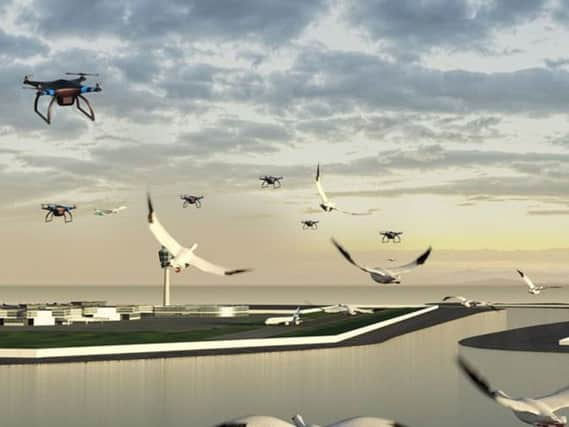Drones plan to cut aircraft bird strikes


The idea is among shortlisted entries to a competition organised by the plane maker for the future of flight.
The drones plan would involve birds being guided away from airports, a bit like sheepdogs rounding up sheep.
Advertisement
Hide AdAdvertisement
Hide AdThe birds would be moved to “birdports” - attractive habitats nearby - using birdsong and decoys.
An Airbus spokesman said: “The idea is designed to reduce bird strikes to aircraft significantly and to enhance aircraft availability.
“The drones use tactics of separation, alignment and cohesion to manipulate flocks and divert them.”
A team of students from Japan who devised the drones scheme will hear if they have won on 27 May. The Fly Your Ideas contest attracted more than 500 entries.
Other shortlisted ideas included using energy from the vibration of aircraft wings in flight to power cabin lighting, and a catering trolley which automatically sorts rubbish.
The aviation industry regards bird strikes as the “biggest manageable risk to safety” and incidents cost airlines globally some £650 million a year.
Edinburgh Airport, Scotland’s busiest, recorded 141 bird strikes from 2012-14.
Elsewhere, among the most dramatic involved an aircraft carrying 155 passengers being forced to ditch in the Hudson river in New York in 2009 after both its engines were knocked out by a flock of geese.
Advertisement
Hide AdAdvertisement
Hide AdA year later, a Thomas Cook plane survived a “significant” bird strike while trying to land at Manchester Airport.
In 2002, a charter plane with two pilots on board ploughed on to a road and hit a car outside Aberdeen Airport after crashing off the runway following a bird strike on one engine.
The greatest risk to aircraft from birds is on take-off and landing, with even the most minor incident estimated to cost an average of £13,000 because of delays caused by inspections to check damage.
The latest incidents in Scotland include a mail flight from Inverness to Stornoway being forced to turn back last month after the pilot reported a bird strike after taking off.
The Civil Aviation Authority said airports had to have measures in place to cut the risk.
Scottish airports such as Edinburgh - the country’s busiest - use a variety of methods from restricting tree growth and broadcasting raptor calls to shooting birds.
A CAA spokesman said: “Bird strikes – especially those involving large and flocking birds - can be a risk to aircraft, and so appropriate mitigation and management measures must be put in place to reduce the risk of an incident occurring.
“Key to this is the effectiveness of the airport’s habitat management - which individual airports are responsible for, in partnership with local authorities and other stakeholders.
Advertisement
Hide AdAdvertisement
Hide Ad“CAA considers airport habitat management across the UK to be generally effective at managing the birds trike hazard, and as a result the number of serious bird strike incidents that occur in the UK is relatively low.
“The CAA has also worked with industry to develop aircraft engines which are capable of withstanding the impact and/or the ingestion of larger flocking birds.”
An Edinburgh Airport spokesman said: “Whilst we’re always ready to embrace new technology and alternative solutions, we have to balance this with the risk of introducing a potential new hazard into the airfield environment.
“We have a very good record of bird hazard management and this remains a top priority due to the very nature of the risk.”
Prestwick Airport chief executive Iain Cochrane said: “We have had zero bird strikes from high risk category birds for over 12 months.
“In certain situations the proposed drone application may be very useful.”
FOLLOW US
SCOTSMAN TABLET AND MOBILE APPS